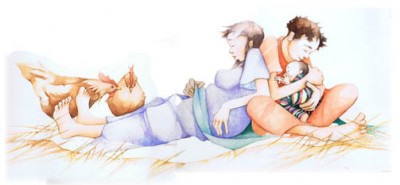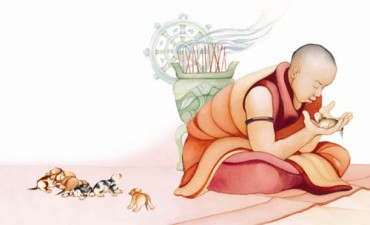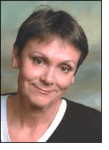"Most people really like that and I like to see it in other people’s work, that light and unconscious touch, drawing that’s just air on the page, not overly thought about, not carefully done.” Julie Vivas
In his latest book, The Element, Sir Ken Robinson asks the reader to imagine a life where you don’t have to worry about making money to survive or what others will think of you. Robinson argues that the pull towards what we most enjoy doing, unhindered by life’s constraints, brings us into our ‘element’.
Award winning children’s book illustrator, Julie Vivas, has never needed to ask Sir Ken’s question. She has been in ‘the element’ for most of her life. An early preference for visual representation nudged her along an artistic path that became more specialised after art school, marriage to a Spanish artist, and the birth of two daughters.
Julie Vivas gained national and international attention through her illustrations for the Mem Fox story, Possum Magic, published in 1983. The original manuscript was rejected by nine publishers before being accepted and published by Omnibus Books, an Adelaide-based company. The book became one of the the highest selling children’s picture books in Australian history and has spawned a musical, a symphony and various spin-off products. Vivas is a highly sought after illustrator and has continued to create arresting visual characters that arouse a range of emotional responses in readers. From the poignant acceptance of change found in Helen Manos’s Samsara Dog and Margaret Wild’s Puffling, to more complex and sometimes controversial representations of historical events such as The Nativity, Vivas’s gentle, tactile and expressive characters have won fans across successive generations of young readers.
Julie Vivas was born in Adelaide. Her father’s business took the family to Melbourne and then Sydney, where they finally settled and where Julie still lives. With her father’s attention drawn towards running a demanding business, her mother, a kindergarten teacher, filled the absence with a rich domestic life of reading, drawing and gardening. Two older cousins would visit during the holidays and share their love of books with Julie and her sister.
“I was very young, about four or five, when I realised I could make sense of things by drawing them,” recalls Julie. “My mother created a tidy and ordered environment. There were drawers with pencils and paper, and children’s books on hand that we could read from. I drew a lot, I would dream about living on a boat or an island and then I would draw it. I understood things visually. If I read something, a recipe for example, I would have trouble understanding it, but if I did a visual plan, it was easier. My early drawings were like maps. I think that is what I still do; I’m working out emotions that I’ve experienced and working out how they fit together.”
Julie’s mother was an unusual woman for her time and place. She was curious about eastern philosophy and practised yoga long before it became fashionable in the west. Julie and her sister were invited to immerse themselves in the beauty of the natural world, a gift that would later become a touchstone for Julie’s art practice, along with yoga.
“We lived in houses with expansive gardens and my mother grew lots of flowers,” Julie reminisces. “We built cubby houses and climbed trees and it fed my imaginary life. We had holidays at the beach on the Mornington Peninsula and the water was so clear you could see the little grains of sand on the bottom.”
For Julie Vivas, this connection to the natural world informs the visual language she has cultivated in her work and is a source of inspiration, ideas and replenishment.
“My first response is to nature, going out into some natural environment. I remember when I was doing The Nativity, I kept going outside at dusk to look at the sky and

The Nativity: illustrated by Julie Vivas based on text from King James Bible
The Nativity: illustrated by Julie Vivas based on text from King James Bible
I kept wishing that I could paint that exact blue. It was just fantastic to see this amazing sky. When I was doing The Tram to Bondi Beach (author Libby Hathorn), I noticed that the sand on the beach looked pink sometimes and of course I know it is just the light. The things that happen around you everyday are the things that I get a lot of energy and delight from.”
art and commerce
Like any professional artist, Vivas works within a system of deadlines, negotiations and various collaborations that are needed to bring a book or object to life within a commercial framework. The tension between an initial creative response to a story and the demands placed upon her to produce a finished work that satisfies the author and her publishers, is a complex terrain that can be a source of both energy and frustration. Having traversed it many times, Vivas knows its contours well.
The experimental phase of the process is the one that Vivas finds most satisfying. Producing a rough cut or ‘dummy book’ can take up to three months. During this time she is exploring shapes and feeling her way into the characters, allowing them to evolve and animate the page.

Scene from Samsara Dog: Story by Helen Manos; illustrations by Julie Vivas
“I’ve come to know that this will be the best time of the whole experience,” she explains. “The work will be the most free that it’s ever going to be and the most expressive. It may not be clear enough for the reader to know what’s going on, but it will carry more emotion in it and the actual touch on the paper will be more spontaneous. Most people really like that and I like to see it in other people’s work, that light and unconscious touch, drawing that’s just air on the page, not overly thought about, not carefully done.”
Julie Vivas relies on instinct, technique and a fine-tuned emotional acuity to dig into her inner world and bring out the empathic qualities needed to animate the characters she has been given by a writer. She trusts this instinctive process and knows its hidden language and limits.
“They are emotional instincts and my understanding of instinct is that you don’t understand it, you feel it or respond to it. I can’t give you a map of what’s happening to me or why. I have to keep drawing until I find something that works, something that triggers a frisson or some kind of recognition. It doesn’t move in a straight line. I like feedback and I like being with people but to do my work well I have to be alone.”
endless iterations
This interplay between the subjective world of creative experimentation and outer demands to produce a finished work, can be laboured.
“It’s an exciting challenge to be offered a manuscript by an author and publisher. At the beginning you say: ‘This is fantastic, this is a great story, I can’t wait to get started’. But until you try something you don’t know how hard it will be.
“Illustrators work in sequences of images that affect the reader emotionally; as you turn the page, the image you have just seen has an affect on the way you see the next one. I try a lot of variations to get this momentum to work. The fear of failure is a driving force for me. When problems arise I just keep drawing, even if it feels mechanical at times. I draw my way out of problems in order to find a solution that hasn’t been thought of before.”

Julie Vivas
When Julie Vivas looks at a finished book, she often reflects on the endless iterations needed to turn ‘air on the page’ into the solidity of a physical object acceptable to everyone involved in the chain of production. It’s tempting for business-oriented people to apply industrial thinking to every link in this chain. But applying these norms to the sometimes fast, sometimes slow, sometimes fully formed and sometimes inchoate world of creative discovery, can be counterproductive. Limits, boundaries and timeframes are critical, but an insensitivity to the space and time needed for experimentation and discovery can rob a finished work, no matter what it is, of originality, lightness – of life.
Being in our ‘element’ enables us to explore and develop our capacity for imagination and creative expression. Julie Vivas has spent a lifetime doing what she loves, and in so doing has given an extraordinary gift to young readers – the ability to explore and develop their own capacity for emotional expression and empathy with others.
Find out how Julie Vivas applies her training in interior design to her work as an illustrator in Project Sisu Sydney Summer 2010


